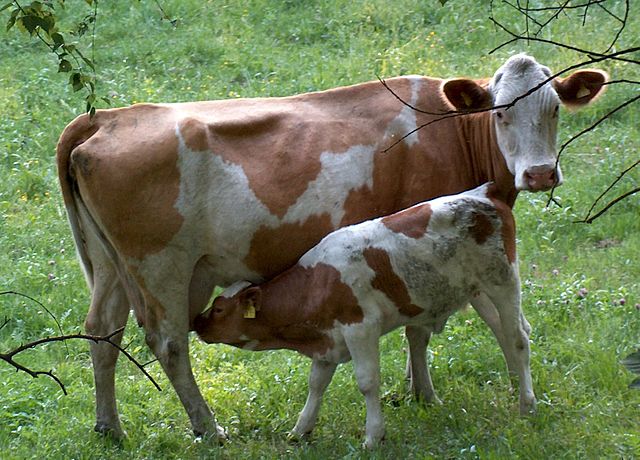
calf.jpg
Calf
Definition:
A calf is a young bovine animal, specifically of the species Bos taurus, typically between the ages of birth to one year old, raised and managed in agricultural settings primarily for growth, development, and future roles in beef or dairy production, breeding programs, or market sales. Calves represent the next generation of cattle herds, serving as calves, weanlings, or young stock in livestock enterprises.
Description:
Calves are domesticated livestock animals, known for their rapid growth, nutritional requirements, and vulnerability to environmental stressors, contributing to cattle farming, animal husbandry, and agricultural activities worldwide. Calves undergo various stages of development, maturation, and transition from dependency to independence in cattle populations.
Fall off the barn roof and busted your keister? Life on the farm or ranch can be tough on the bum. Need a break? Laugh it off at FarmerCowboy.com, the #1 farm humor site. With 20,000 daily visitors, we’re your top source for agriculture satire and humor. Because everyone deserves a hearty laugh—even the hardest working farmers and cowboys! Join us and turn those long days into fun tales at FarmerCowboy.com.
Characteristics of Calves:
Calves exhibit various physical and behavioral characteristics, including:
- Age: Calves are young cattle, typically born from cows or heifers, with birth weights ranging from 40 to 100 pounds, growing rapidly during the neonatal period, nursing from their dams, and transitioning to solid feed, water, or supplemental nutrition during the weaning process, achieving maturity and independence over time.
- Growth Rate: Calves experience rapid growth and development, doubling their birth weights within the first few weeks of life, gaining weight at an average daily gain (ADG) of 1.5 to 2.5 pounds per day, reaching target weights, and maturity milestones for weaning, breeding, or market readiness in cattle production systems.
- Nutritional Requirements: Calves have specific nutritional needs, including colostrum, milk, or milk replacer during the pre-weaning phase, transitioning to starter feeds, grains, and forages during the post-weaning phase, requiring balanced diets, vitamins, minerals, and protein sources to support growth, immunity, and metabolic health in calf populations.
- Health Management: Calves are susceptible to various health challenges, including infectious diseases, nutritional disorders, or environmental stressors, requiring vaccination programs, deworming protocols, and herd health management practices to prevent illness, reduce mortality rates, and promote calf welfare in livestock operations.
Uses of Calves:
Calves serve various purposes in agriculture and livestock management, including:
- Replacement Stock: Calves are raised as replacement heifers or future breeding females in cattle breeding programs, selected for genetic traits, reproductive performance, or herd productivity, entering the breeding herd after reaching sexual maturity, breeding readiness, or target body weights.
- Feeder Cattle: Calves may be raised as feeder cattle or stocker cattle, entering stocker programs, backgrounding facilities, or grazing systems, to promote growth, development, and conditioning before entering feedlot finishing programs, beef production systems, or market sales as finished cattle.
- Veal Production: Calves raised for veal production are managed differently, confined in individual stalls or group pens, fed specialized diets, and harvested at a younger age, typically between 4 to 16 weeks old, producing tender, mild-flavored veal meat for consumer markets, culinary applications, or foodservice establishments.
Conclusion:
Calves are essential components of cattle farming, beef production, and dairy operations, representing the future of livestock herds, genetic diversity, and agricultural sustainability in rural communities worldwide. By raising calves responsibly, providing proper care, and implementing best management practices, farmers can ensure the welfare, productivity, and prosperity of calf populations for future generations.
References:
- Galyean, M. L., et al. (2019). Nutritional strategies for managing weaned calves and forages for growing cattle. Journal of Animal Science, 97(11), 4509-4527.
- Van Amburgh, M. E., et al. (2018). Nutritional management of dairy calves and replacement heifers: A review focusing on the transition period. Journal of Dairy Science, 101(12), 10505-10525.
Originally posted 2012-02-20 02:02:45.
Originally posted 2024-06-23 18:42:37.
Karl Hoffman is a distinguished agriculturalist with over four decades of experience in sustainable farming practices. He holds a Ph.D. in Agronomy from Cornell University and has made significant contributions as a professor at Iowa State University. Hoffman’s groundbreaking research on integrated pest management and soil health has revolutionized modern agriculture. As a respected farm journalist, his column “Field Notes with Karl Hoffman” and his blog “The Modern Farmer” provide insightful, practical advice to a global audience. Hoffman’s work with the USDA and the United Nations FAO has enhanced food security worldwide. His awards include the USDA’s Distinguished Service Award and the World Food Prize, reflecting his profound impact on agriculture and sustainability.






